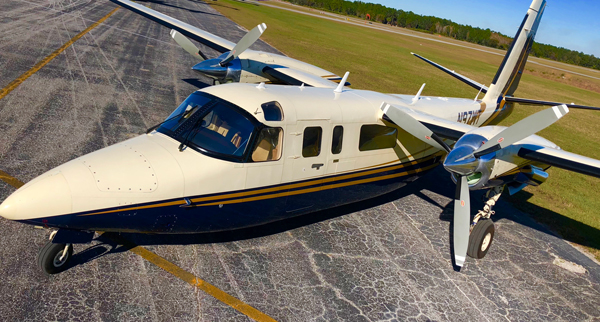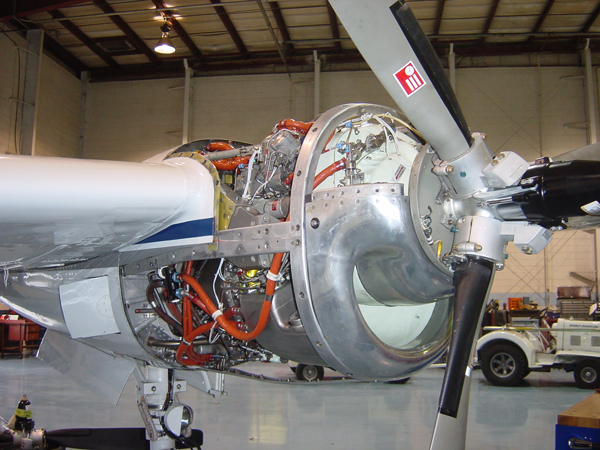FLIGHT LEVELS PROFILE: I’M ‘LOVING MY COMMANDER’

Kent Titcomb recently upgraded from a Cessna 414A to a Twin Commander 840. A few months into ownership of the Commander, he drew on a literary reference to describe its qualities. “Zen and the Art of Motorcycle Maintenance, Robert Persig’s iconic 1974 book, was a philosophical examination of the marriage of the technical with the emotions,” Titcomb observed. “The Commander is a beautiful example of that Zen. A blend of exceptional speed, exceptional fuel burn, reasonable purchase price, reasonable maintenance costs, cabin size, and payload/range flexibility. What machine can do more for less? Did I mention excellent short-field performance? Did I mention how good the aircraft flies? Ramp presence?”
Titcomb writes glowingly about his Commander in the latest issue of Flight Levels. The issue also profiles a rejuvenated Byerly Aviation, a long-time Twin Commander authorized service center that is now under the ownership and management of Scott Welch and Bruce Byerly. “Business Flying and Taxes” consultant Suzanne Meiners-Levy provides insight on how the new tax law affects aircraft owners, buyers, and sellers.
Commander historian Barry Collman writes about the Model 1200 prototype that Gulfstream Aerospace’s Commander Division built and marketed but did not approve for production. And Twin Commander LLC President Matt Isley reflects on how two pearls of wisdom—“The more things change, the more they stay the same,” and “The only constant is change,” apply equally to the Twin Commander.
Flight Levels subscribers should have received the latest issue. If you’re not receiving Flight Levels, you can sign up for a free subscription at www.twincommander.com. You can also view the issue online at www.flightlevelsonine.com.
GO SOCIAL
Flight Levels and the Twin Commander eLetter are not the only way Twin Commander communicates with Commander owners, operators, pilots, and enthusiasts. Have you checked out Twin Commander’s Facebook page, Tweets, and Instagram photo postings? Readership and viewing of the Twin Commander social media sites is steadily increasing. One recent Twin Commander Tweet referred to Clive Cussler, the noted adventure writer, who in his book The Race refers to pilots as “drivers.” The Tweet found its way to Cussler, who “liked” it.
The Twin Commander Instagram site is loaded with great photos of people, places, and airplanes in flight and on the ramp.
To join in the fun go to www.twincommander.com and scroll down a bit to the “Social” collection of icons for Twitter, Facebook, and Instagram. Click on each one to see what’s happening in the Twin Commander world, and post about your Twin Commander experiences.
FAA ISSUES HONEYWELL TPE331INSPECTION A.D.

The FAA has issued Airworthiness Directive 2018-02-14 calling for an inspection of TPE331 engines to check for weld cracks in the combustion chamber plenum.
The FAA said the AD was prompted by reports that combustion chamber case assemblies have cracked and ruptured. The AD was issued “to prevent failure of the combustion chamber case assembly. The unsafe condition, if not addressed, could result in failure of the combustion chamber, in-flight shutdown, and reduced control of the airplane.”
The inspection, which can be completed in an hour or less according to the AD, involves all accessible areas of the combustion chamber case assembly, focusing on the weld joints, and must be completed before accumulating 450 hours in service since the last fuel nozzle inspection or within 50 hours in service after the February 28, 2018 effective date of this AD, whichever occurs later.
Honeywell said the AD “mainly affects the higher-pressure “flowerpot/-8+” engines, but the older P/C through -6 engines have some plenums with a lot of time on them.”
Operators who have been accomplishing published safety SBs should not have any problems with the combustion chamber cases, Honeywell noted. The company recommends that any time the plenum exterior is accessed, a quick visual be performed on all accessible weld joints. When the turbine is accessed the plenum should be updated with modified bosses, which is called for in the SB and AD.
Honeywell said its combustion chamber service bulletins are all Category 1 Safety Bulletin(s) that recommend replacing the combustion chamber (plenum) with a new improved design at the next event (either scheduled or unscheduled maintenance necessitating removal), but with a final compliance no later than March 2021. The FAA AD compliance differs from the Honeywell SB recommendations in that the AD continues the recurring visual inspections (until the plenum is replaced with new improved design), disqualifies certain old-design plenums from being reinstalled on National Flight Service STC’d engines, and requires all currently installed plenums on those engines be replaced before accumulating an additional 3700 hours following release of the AD.
Following is Honeywell’s guidance regarding the A.D.
- Confirm part number of plenum installed (the IPC allows the use of several different plenum part numbers). If the installed plenum is a P/N 869728-X, 893973-X, 3101668-X or 3102613-X then this A.D. is applicable. (Note – if installed plenum part number is listed in the engine’s applicable IPC and is NOT one of these four listed suspect part numbers, then this A.D. can be signed off as “N/A by plenum part number”).
- If the installed plenum part number is one of the four suspect plenum part numbers, operators shall then inspect the plenum per SB 72-2178 R.0 before engine accumulates 450 hours since last fuel nozzle inspection OR within 50 hours after effective date of this A.D., whichever occurs later.
- For TPE331-3U, -3UW, -5, -5A, -5AB, -5B, -6, and -6A engines found to have a P/N 869728-1, 869728-3, or 893973-5 plenum installed (one without the one-piece bleed pad; refer to A.D. for picture) or TPE331-1, -2, and -2UA engines that have been modified for STC SE383CH by National Flight Services, Inc., those plenums must be removed from service at the next removal of the plenum from the engine or within 3700 hours time-in-service since last hot-section inspection.
- For TPE331 models -8 and subsequent, you need only re-inspect the plenum at each scheduled fuel nozzle inspection (intervals of which are not to exceed 450 hours) until plenum is replaced for cause.
- The A.D. has special provisions for FAR Part 135/121 operators. They should consult with their authorized Twin Commander service center for details.
For more information contact your authorized Twin Commander service center

